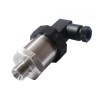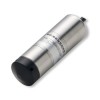A 4-20mA current signal has become very popular for many applications beyond it’s original intended purpose in the process industry. It is now used throughout industry as the preferred measurement and control signal for many different types of systems.
Despite the popularity of the 4-20mA signal, it is not the best solution for every application and here are some of the ‘for’ and ‘against’ reasons for determining whether it is the right type of signal for your application.
Featured 4-20ma signal related products
 Chemical Resistant Pressure Sensor Elements for Electronic Devices & Embedded Product Design & Development - Pressure sensor elements with sensing diaphragms made from alumina ceramic (Al2O3) for electronic & mechanical oem integration into measurement & control instrumentation designs.
Chemical Resistant Pressure Sensor Elements for Electronic Devices & Embedded Product Design & Development - Pressure sensor elements with sensing diaphragms made from alumina ceramic (Al2O3) for electronic & mechanical oem integration into measurement & control instrumentation designs. IMP Low Cost Pressure Sensor - Versatile low price pressure sensor with a wide selection of electrical and mechanical options for customisation.
IMP Low Cost Pressure Sensor - Versatile low price pressure sensor with a wide selection of electrical and mechanical options for customisation.
Advantages
- It can be run over long distances with minimal signal losses compared to voltage type signals
- A varying current loop load impedance or supply voltage will not significantly affect the signal as long as it does not exceed recommended component limits
- Rugged signal with low electromagnetic susceptibility
- Saves on cable wire because it only needs 2 wires to function
- Live zero reading verifies sensor is electrically functional
Disadvantages
- High power consumption compared to other analogue signal types
- Elevated output at zero reading
- Supply not isolated from output
- Increasing circuit load resistance, will reduce the supply voltage available to power the transmitter that is generating the 4-20mA signal.
Featured 4-20ma signal related products
 TPSA Precision High Pressure Transducer - High pressure transducer for pressure testing applications with pressure ranges from 0...4 bar (60 psi) up to 0...1000 bar (15,000 psi) gauge with a measurement accuracy of 0.1%.
TPSA Precision High Pressure Transducer - High pressure transducer for pressure testing applications with pressure ranges from 0...4 bar (60 psi) up to 0...1000 bar (15,000 psi) gauge with a measurement accuracy of 0.1%.  3m range 4-20mA output submersible hot water tank level sensor - This submersible level sensor is suitable for use in hot water tanks. It features a 4-20mA output, 0-3m measurement range, and high-temperature resistance up to 125°C (257°F).
3m range 4-20mA output submersible hot water tank level sensor - This submersible level sensor is suitable for use in hot water tanks. It features a 4-20mA output, 0-3m measurement range, and high-temperature resistance up to 125°C (257°F).
Related Help Guides
- Supply voltage and load resistance considerations for pressure transmitters
- How to Connect a 4-20mA Current Loop Pressure Transmitter
- Why use 4-20mA and 3-15 psi rather than 0-20mA & 0-15psi
- Transforming a 2 wire Current Loop into a Voltage Output Signal
- How do you measure flow rate with a dp cell
- How to get a 10 volt signal from a 4-20mA output pressure sensor
- What is the difference between a pressure transducer and a transmitter
- Choosing calibrator for pressure transmitters
- How to create a list of specification parameters for a pressure sensor
Related Technical Terms
- 2 Wire
- 4 to 20 mA Current Loop Output Signal
- HART®
- Square Root Extraction
- Stainless Steel Pressure Sensors
- Transmitter
- Turndown Ratio
Related Online Tools
- Pressure Transmitter 4-20mA Current Output Calculator
- Flow Transmitter 4-20mA Current Output Calculator
- DP Flow Transmitter Output Calculator
- 4-20mA Signal to Measurement Reading Converter
- SqRt Extraction 4-20mA Signal to Measurement Reading Converter
- Temperature Transmitter 4-20mA Current Output Calculator
- Liquid Level Transmitter 4-20mA Current Output Calculator
- 4 to 20 mA Supply, Load, Shunt and Signal Calculator
